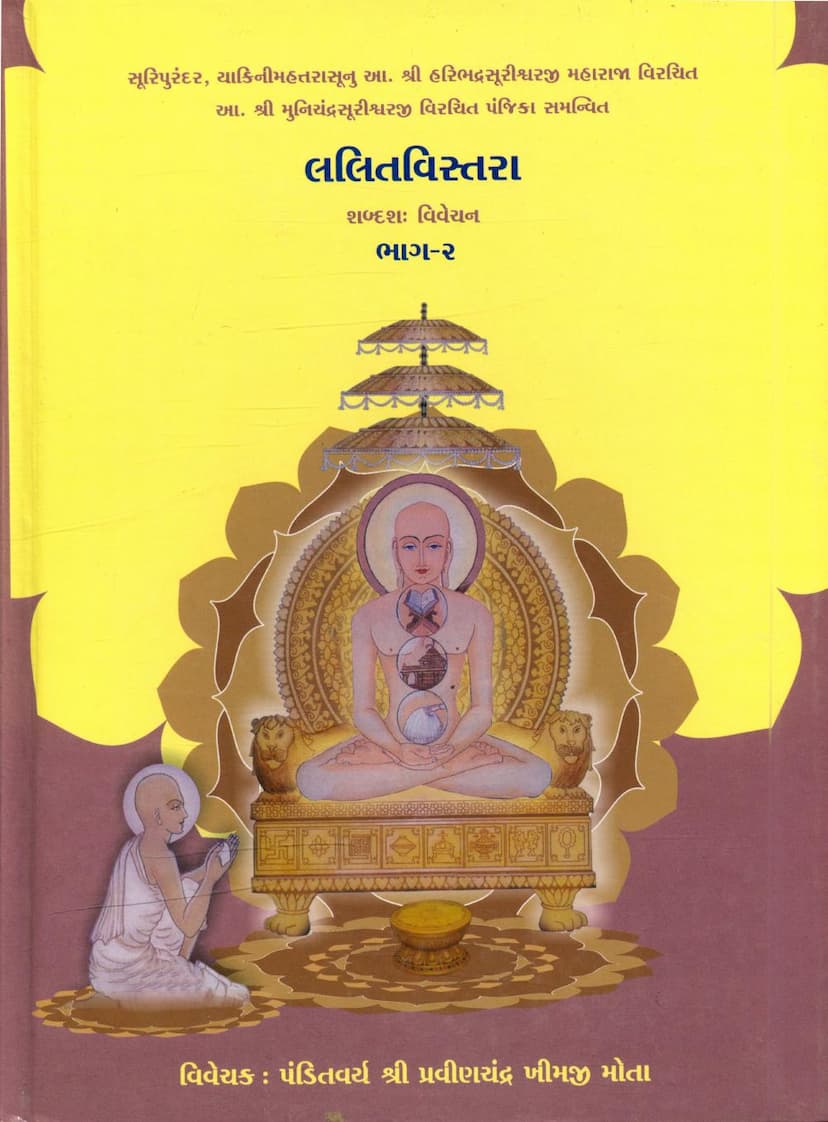Lalit Vistara Part 02
Added to library: September 2, 2025

Summary
Lalita Vistara Part 02: A Comprehensive Summary
This Jain text, "Lalita Vistara Part 02," authored by Pravinchandra K Mota and published by Gitarth Ganga, serves as a detailed word-by-word commentary (shabdasha vishvasan) on the "Lalitavistara" attributed to Acharya Shri Haribhadrasuri Maharaj and further elaborated with a commentary (panchika) by Acharya Shri Munichandrasuri Maharaj. The commentary itself is presented through the insights of Pandit Varay Shri Pravinchandra Khimji Mota, with blessings and guidance from respected Jain Acharyas.
The core purpose of this book, as highlighted in the "Prakashakiy" (publisher's note), is to illuminate the profound mysteries of Jainism. The text emphasizes that merely obtaining knowledge of Jainism is insufficient; true benefit comes from understanding its deep secrets, cultivating unwavering respect for the faith, and maintaining a firm resolve for the path of spiritual practice.
The book delves into the intricate meanings and nuances of Jain scriptures, aiming to resolve apparent contradictions and reveal hidden truths. It acknowledges that these profound truths may not be easily digestible for all, as they represent the essence of the profound Jain teachings.
Key Themes and Content:
The "Lalita Vistara Part 02" focuses on a systematic exposition of the "Namuṭṭhuṇam" (Namoṭṭhuṇam) sutra, a fundamental Jain invocation, and its deeper spiritual significance. The commentary meticulously breaks down each aspect of this sacred verse, linking it to the path of liberation and spiritual progress.
The commentary emphasizes the following key concepts, structured around the analysis of the "Namuṭṭhuṇam" verse:
-
The Nature of "Namuṭṭhuṇam" and its Significance: The text explains that "Namuṭṭhuṇam" is not merely a salutation but a profound invocation that, when understood and practiced correctly, leads to immense spiritual merit and the shedding of karma. It highlights the importance of understanding the "why" behind the invocation, not just the "what."
-
The Importance of the "Fivefold" (Panchamukha) and its Relationship to "Namuṭṭhuṇam": The commentary meticulously analyzes the fivefold classification (e.g., Abhayadāṇaṁ, Chakshuḍāṇaṁ, etc.), explaining how each aspect is interconnected with the principles of "Namuṭṭhuṇam." It clarifies the spiritual significance of offering "Abhaya" (fearlessness) through devotion, "Chakshu" (vision) through righteous understanding, "Mārga" (path) through righteous conduct, "Sharaṇa" (refuge) through faith in the Tirthankaras, and "Bodhi" (enlightenment) through the teachings of the Jinas.
-
The Role of Tirthankaras: The text extols the Tirthankaras as the ultimate spiritual guides, whose statues ("chaitya") are revered. It explains that bowing to these representations ("chaitya vandanam") cultivates auspicious thoughts in the devotee, leading them towards the state of the Tirthankaras themselves.
-
The "Fivefold" (Panchamukha) and its Connection to "Namuṭṭhuṇam": The text intricately links each of the five spiritual offerings (Abhayaḍāṇaṁ, Chakshuḍāṇaṁ, Mārgadāṇaṁ, Sharaṇaḍāṇaṁ, Bodhiḍāṇaṁ) to the underlying principles of "Namuṭṭhuṇam." It elaborates on how each offering contributes to spiritual growth and the ultimate goal of liberation.
-
The Seven Types of Fear (Saptadha Bhaya): The commentary delves into the seven types of fear that afflict beings in the cycle of birth and death, and how "Abhaya" (fearlessness), a key aspect of "Namuṭṭhuṇam," counters these fears.
-
The Nature of True Knowledge and Vision (Chakshudāṇaṁ): The text differentiates between external sensory vision and the internal, spiritual vision that leads to the true understanding of reality, emphasizing the importance of the latter in the path to liberation.
-
The Meaning of the Path (Mārgadāṇaṁ): The commentary elucidates the significance of the righteous path shown by the Tirthankaras, highlighting its role in overcoming suffering and achieving ultimate bliss.
-
The Refuge (Sharaṇadāṇaṁ): The text explains the concept of seeking refuge in the Tirthankaras and their teachings as a crucial step in spiritual progress, providing solace and guidance amidst the trials of life.
-
Enlightenment (Bodhiḍāṇaṁ): The ultimate goal of the spiritual journey is enlightenment, and the commentary details how the teachings and practices prescribed in Jainism lead to this state of liberation.
-
Righteous Conduct and its Importance (Dharmadāṇaṁ, Dharmadeśaka, Dharmasārathi, Dharmavarachakravartī): The book elaborates on the importance of righteous conduct in all aspects of life, highlighting the role of the Jinas as guides, law-givers, charioteers, and ultimately, the embodiment of the highest Dharma.
-
The Nature of True Knowledge and Vision (Apraṭihaṭavarajñānadarśana): The text emphasizes that true knowledge and vision are unhindered and all-pervasive, a state achieved through the destruction of karmic obstructions.
-
The State of Liberation (Muktāṇam Mokṣagāṇaṁ): The commentary describes the state of liberated souls, free from all worldly attachments and suffering, residing in a state of eternal bliss.
-
The Role of "Namo Jinebhyah Jitabhyāṇam": The text highlights the significance of this specific invocation, emphasizing the victorious nature of the Jinas who have conquered all inner enemies (karmas) and therefore serve as true inspirations for us to conquer our own inner adversaries.
-
The Concept of One Essence, Many Forms: The book touches upon the philosophical concept of unity in diversity within Jainism, where the divine essence is seen in multiple forms, all pointing towards the ultimate truth.
-
The Importance of Righteous Intent and Practice: The commentary stresses that the true efficacy of religious practices lies not just in external actions but in the inner state of mind, intention, and sincere devotion.
The publisher's note also lists numerous other publications by Gitarth Ganga, covering a wide range of Jain philosophical and practical topics, further underscoring the organization's commitment to disseminating Jain knowledge. The book serves as a valuable resource for scholars, practitioners, and anyone seeking a deeper understanding of the rich philosophical and spiritual heritage of Jainism, particularly through the lens of detailed scriptural analysis.